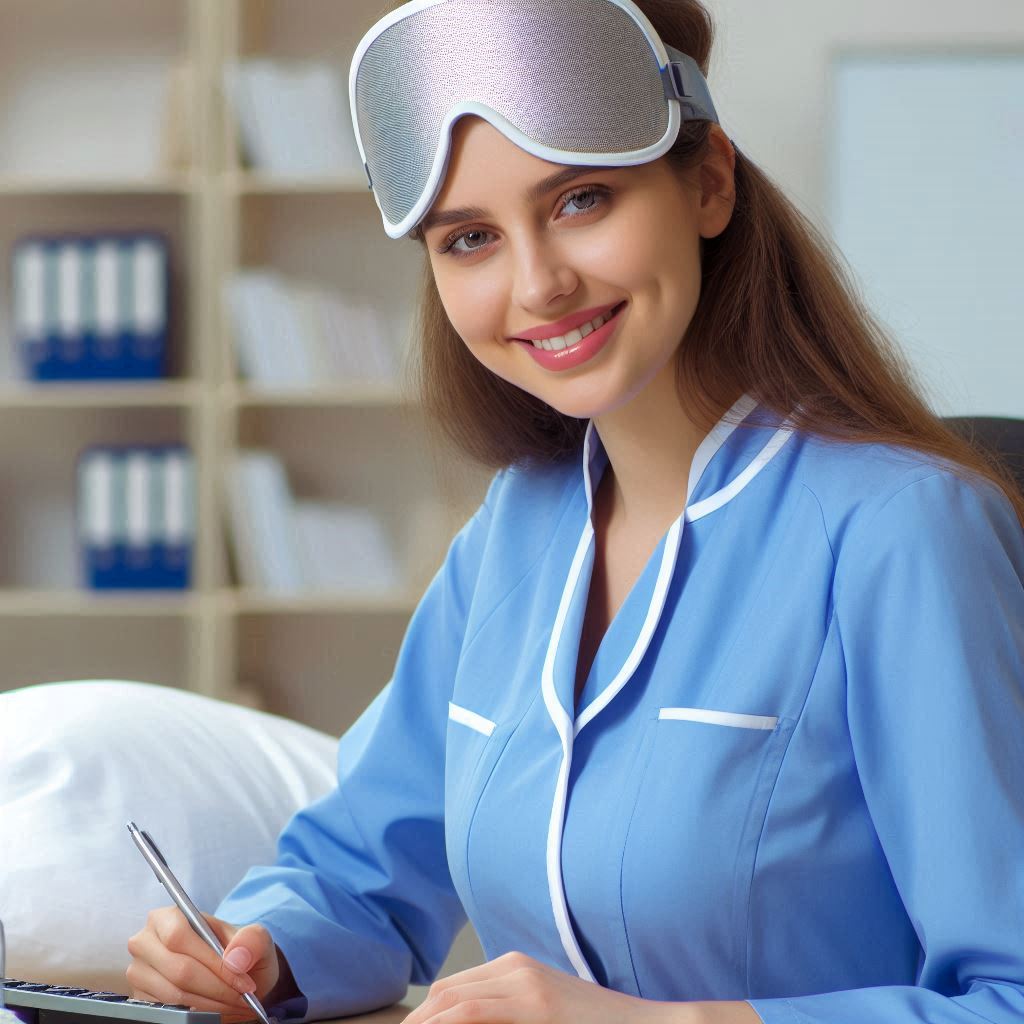Introduction
A sleep technologist plays a crucial role in healthcare, diagnosing and treating sleep disorders through specialized testing methods.
These professionals conduct comprehensive sleep studies, monitor patients overnight, and analyze the collected data to provide accurate and detailed assessments.
Beyond their technical skills, their ability to interact empathetically ensures patient comfort and cooperation during these procedures.
In a constantly evolving field, staying updated on industry trends and technological advancements is essential for all sleep technologists.
This proactive approach enhances their ability to deliver high-quality care.
It also enables them to integrate new tools effectively.
By remaining updated, sleep technologists can readily adapt to changes in diagnostic protocols and advanced treatment options.
Most importantly, sleep technologists must embrace continuous learning to stay current with the latest advancements and best practices.
By staying informed, sleep technologists provide the most effective care.
They significantly contribute to the progress of sleep medicine.
Education and Training Requirements
Becoming a sleep technologist typically requires a combination of formal education and specialized training to effectively perform the duties associated with diagnosing and treating sleep disorders.
Educational Background
The most common educational path to becoming a sleep technologist involves obtaining an associate’s degree in polysomnography or a related field.
These programs typically cover subjects such as anatomy, physiology, sleep disorders, and the operation of diagnostic equipment used in sleep studies.
Some institutions may offer certificate programs as an alternative to an associate’s degree, although these may require prior healthcare experience.
Certifications and Licenses
While requirements can vary by region and employer, many jurisdictions require sleep technologists to obtain certification.
The most recognized certification in the field is the Registered Polysomnographic Technologist (RPSGT) credential, awarded by the Board of Registered Polysomnographic Technologists (BRPT).
To qualify for the RPSGT exam, candidates usually need to complete an accredited educational program and accrue a certain number of clinical hours.
In addition to certification, some states or countries may require sleep technologists to obtain a license to practice independently.
This typically involves meeting specific educational and experience requirements, passing an exam, and fulfilling continuing education obligations to maintain licensure.
Completing these educational and certification requirements equips aspiring sleep technologists with essential knowledge and skills.
They perform sleep studies competently while ensuring compliance with professional standards and regulations.
Advancements in Sleep Monitoring Technology
Technology is constantly evolving, and the field of sleep medicine is no exception.
Sleep technologists are at the forefront of utilizing these advancements to improve the diagnosis and treatment of various sleep disorders.
Latest Technologies Used in Sleep Labs
- Polysomnography (PSG): A comprehensive test that monitors various physiological parameters during sleep, such as brain waves, eye movements, and muscle activity.
- Actigraphy: A non-invasive method of monitoring sleep-wake patterns over extended periods using a device worn on the wrist.
- Home Sleep Apnea Testing (HSAT): Portable devices that allow patients to undergo sleep studies in the comfort of their own homes.
- Continuous Positive Airway Pressure (CPAP) Machines: Devices that deliver pressurized air to keep airways open during sleep, commonly used to treat sleep apnea.
Improvements in Diagnosis and Treatment of Sleep Disorders
These advancements in sleep monitoring technology have revolutionized the way sleep disorders are diagnosed and treated.
Here are some ways they have made a significant impact:
- Enhanced Accuracy: PSG provides detailed insights into sleep patterns, allowing for a more accurate diagnosis of sleep disorders.
- Convenience: HSAT devices offer a convenient alternative to in-lab sleep studies, reducing the need for overnight hospital stays.
- Personalized Treatment: Sleep technologists can tailor treatment plans based on individual sleep patterns and disorder severity.
- Improved Patient Compliance: CPAP machines with advanced features like smart technology and data tracking encourage better adherence to treatment.
In fact, advancements in sleep monitoring technology play a crucial role in the field of sleep medicine, enabling sleep technologists to provide better care and outcomes for patients with sleep disorders.
Read: Benefits of a Career as an Ultrasound Technician
Shift Towards Remote Monitoring
Growing Trend Of Remote Sleep Monitoring
Remote sleep monitoring is a growing trend in the field of sleep technology.
This method involves tracking and analyzing an individual’s sleep patterns and behaviors outside of a traditional sleep lab setting.
Let’s explore the benefits and challenges associated with this shift towards remote monitoring.
Benefits of Remote Monitoring
- Convenience: Remote sleep monitoring allows individuals to undergo sleep studies in the comfort of their own homes, eliminating the need to travel to a sleep lab.
- Cost-effective: By reducing the need for overnight stays in a sleep lab, remote monitoring can lower overall healthcare costs for patients and healthcare providers.
- Real-world data: Monitoring sleep in a natural environment provides more accurate and realistic data about an individual’s sleep habits and patterns.
- Accessibility: Remote monitoring can reach a wider population, including individuals in rural or remote areas who may not have easy access to a sleep lab.
- Improved compliance: Some individuals may feel more comfortable and relaxed sleeping at home, leading to more accurate data and better compliance with the study protocol.
Challenges of Remote Monitoring
- Lack of supervision: Without direct oversight from sleep technologists and healthcare professionals, there may be concerns about the accuracy and reliability of remote sleep monitoring data.
- Data security and privacy: Transmitting sensitive health information over the internet can raise issues related to data security and patient privacy.
- Equipment calibration: Ensuring that monitoring devices are properly calibrated and functioning correctly without in-person supervision can be a challenge with remote monitoring.
- Patient education: Individuals participating in remote sleep monitoring studies may require additional education and support to properly set up and use monitoring equipment.
- Limited diagnostic capabilities: Remote monitoring may not offer the same level of diagnostic capabilities as traditional in-lab sleep studies, potentially leading to missed or inaccurate diagnoses.
Remote sleep monitoring provides benefits like convenience, cost-effectiveness, and accessibility.
However, it poses challenges such as lack of supervision.
Data security concerns are another issue.
Diagnostic capabilities also have limitations.
As technology continues to advance, addressing these challenges will be crucial in ensuring the effectiveness and reliability of remote monitoring in the field of sleep technology.
Read: Ultrasound Technician vs. Radiologic Technologist
Focus on Patient-Centered Care
In the field of sleep medicine, a patient-centered approach is crucial for providing effective care and improving outcomes.
By focusing on the individual needs and preferences of each patient, sleep technologists can tailor treatment plans to address their specific concerns and goals.
The importance of a patient-centered approach in sleep medicine
A patient-centered approach in sleep medicine involves taking into account the unique characteristics of each individual, such as their sleep patterns, lifestyle, and medical history.
By understanding these factors, sleep technologists can develop personalized treatment plans that are more likely to be effective and sustainable.
Trends in the industry are shifting towards personalized care for patients with sleep disorders
One of the key trends in sleep medicine is the increasing focus on personalized care for patients with sleep disorders.
This shift is driven by recognizing that one-size-fits-all treatment approaches often fail to address underlying sleep disturbance causes.
By adopting a patient-centered approach, sleep technologists can develop treatment plans that cater to unique needs and preferences.
This approach improves patient satisfaction and increases the likelihood of successful treatment outcomes for those with sleep disorders.
Additionally, personalized care helps to minimize risks of adverse effects and complications associated with standard treatments.
Furthermore, personalized care enhances patient engagement and adherence to treatment plans.
When patients feel their needs and preferences are considered, they are more likely to participate actively in their care.
This can lead to better long-term outcomes and improved quality of life for patients with sleep disorders.
A patient-centered approach is essential in sleep medicine for addressing unique sleep issues effectively.
Read: Surgical Technologist Job Outlook: Demand and Opportunities

Increased Demand for Sleep Technologists
The demand for healthcare professionals specializing in sleep medicine, including sleep technologists, has been steadily increasing in recent years, driven by several factors:
The rising demand for healthcare professionals specializing in sleep medicine
Growing Awareness and Diagnosis of Sleep Disorders
As awareness of sleep disorders such as sleep apnea, insomnia, and restless leg syndrome continues to rise, more individuals are seeking diagnosis and treatment.
This has led to an increased demand for sleep studies and diagnostic services provided by sleep technologists.
Aging Population
With the global population aging, the prevalence of sleep disorders tends to increase.
Older adults are more likely to experience sleep-related issues, necessitating more comprehensive diagnostic evaluations and treatments.
Expanded Research and Treatment Options
Advances in sleep medicine, including new diagnostic technologies and treatment modalities, have expanded the scope of services offered by sleep clinics and healthcare facilities.
This expansion creates a greater need for trained professionals who can operate sophisticated equipment and interpret complex data accurately.
Career Opportunities and Growth Potential
Career opportunities for sleep technologists are expected to expand significantly in response to the growing demand for sleep disorder diagnosis and treatment.
Some key areas of growth and potential opportunities include:
Transform Your Career Today
Unlock a personalized career strategy that drives real results. Get tailored advice and a roadmap designed just for you.
Start Now- Clinical Settings: Sleep technologists primarily work in sleep clinics, hospitals, and specialized sleep centers. They perform overnight sleep studies, monitor patients during sleep, and analyze data to assist physicians in diagnosing sleep disorders.
- Research and Development: With ongoing research in sleep medicine, there are opportunities for sleep technologists to contribute to clinical trials, research studies, and the development of new diagnostic tools and treatments for sleep disorders.
- Telemedicine: The rise of telemedicine has also created opportunities for sleep technologists to conduct remote monitoring of patients’ sleep patterns and provide virtual consultations, expanding access to sleep medicine services.
- Education and Training: Experienced sleep technologists may pursue roles in education and training, teaching aspiring technologists and healthcare professionals about sleep disorders, diagnostic techniques, and patient care protocols.
Sleep technology offers promising career prospects and growth potential.
Individuals interested in healthcare, technology, and improving patients’ lives can benefit.
They can manage sleep disorders effectively.
As the demand for sleep medicine services continues to rise, so too will the opportunities for skilled and certified sleep technologists to make a meaningful impact in this specialized field.
Read: Interview Tips for Landing a Surgical Technologist Job
Impact of COVID-19 on Sleep Medicine
As we navigate through the unprecedented challenges brought on by the COVID-19 pandemic, the field of sleep medicine has also been significantly impacted.
Let’s delve into how this global health crisis has affected the practice of sleep medicine and explore the emerging industry trends:
Impact on Sleep Medicine Practices
- Sleep labs and clinics had to implement strict safety protocols to ensure patient and staff safety.
- Telemedicine became a popular alternative for conducting consultations and follow-ups with patients.
- Many sleep studies were postponed or canceled, leading to delays in diagnoses and treatments.
- Patients with sleep disorders experienced heightened stress and anxiety, affecting their sleep patterns.
Industry Trends Emerging from the Pandemic
- Increased focus on remote monitoring and home sleep testing to minimize in-person contact.
- Integration of digital health platforms for virtual consultations and treatment delivery.
- Development of innovative wearable devices for sleep tracking and monitoring at home.
- Emphasis on mental health support for patients dealing with sleep disturbances due to pandemic-related stress.
Overall, the COVID-19 pandemic has accelerated telemedicine and digital health solutions in sleep medicine.
The global health crisis posed significant challenges, but it also paved the way for new approaches.
We now have innovative methods to diagnose and treat sleep disorders.
Conclusion
The sleep technology field is experiencing significant growth and transformation, driven by key industry trends and emerging innovations.
Increasing awareness and diagnosis of sleep disorders are major factors contributing to this growth and evolution.
An aging population also drives the demand for sleep technologists, as older adults experience more sleep-related issues.
Advancements in research and treatment options are creating new opportunities for the diagnosis and management of sleep disorders.
These trends highlight the rising demand for skilled sleep technologists, resulting in numerous career opportunities and potential for professional growth.
As sleep medicine continues to evolve, it is crucial for sleep technologists to stay informed.
Adapting to new technologies and methodologies is essential for providing the highest quality of care and maintaining expertise.
By keeping updated on advancements in diagnostic tools, treatment protocols, and patient care practices, sleep technologists can excel.
Ultimately, the future of sleep technology is bright, with significant growth and transformation driven by industry trends.
Staying informed and adapting to changes in sleep medicine will ensure the ongoing success and advancement of sleep technologists.
[E-Books for Sale]
The Big Book of 500 High-Paying Jobs in America: Unlock Your Earning Potential
$19.99 • 500 High-Paying Jobs • 330 pages
Explore 500 high-paying jobs in America and learn how to boost your career, earn more, and achieve success!
See All 500 High-Paying Jobs of this E-Book
1001 Professions Without a Degree: High-Paying American Jobs You Can Start Now
$19.99 • 1001 Professions Without a Degree • 174 pages
Discover 1001 high-paying jobs without a degree! Unlock career tips, skills, and success strategies for just $19.99!




